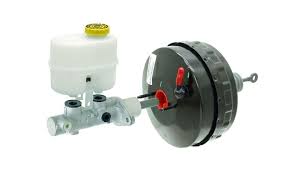How Hydraulic Brake Systems Work: A Guide to Safer Driving

The hydraulic brake system is one of the most critical safety features in modern vehicles. It ensures smooth and efficient braking, providing the control needed to navigate busy roads safely. Understanding how this system works can help you maintain your car better and recognize when it’s time for a repair or replacement.
In this article, we’ll break down the components, working principles, and maintenance tips of hydraulic brake systems. Plus, discover where to find top-quality brake components for your car.
What Is a Hydraulic Brake System?
A hydraulic brake system uses fluid pressure to transfer the force from your brake pedal to the braking mechanism at the wheels. This type of braking system is widely used in passenger vehicles due to its efficiency, reliability, and ability to provide consistent braking power.
Key Components of a Hydraulic Brake System
To understand how hydraulic brakes work, let’s look at their main components:
- Brake Pedal: The starting point of the braking process, where the driver applies force.
- Master Cylinder: Converts the mechanical force from the pedal into hydraulic pressure.
- Brake Fluid: Transmits pressure through the system.
- Brake Lines and Hoses: Carry brake fluid from the master cylinder to the brake calipers or wheel cylinders.
- Brake Calipers (Disc Brakes): Press brake pads against the rotor to slow the wheel.
- Wheel Cylinders (Drum Brakes): Push brake shoes against the drum to create friction.
- Brake Pads and Shoes: Friction materials that contact the rotor or drum to slow the vehicle.
- Brake Rotors and Drums: Rotating components that the pads or shoes press against to stop the wheels.
How Hydraulic Brake Systems Work
The hydraulic brake system operates based on Pascal’s Principle, which states that pressure applied to a fluid in a closed system is transmitted equally in all directions. Here’s a step-by-step breakdown:
-
Pressing the Brake Pedal
- When you press the brake pedal, it activates the master cylinder.
-
Generating Hydraulic Pressure
- The master cylinder compresses brake fluid, creating hydraulic pressure.
-
Transmitting Pressure Through Brake Lines
- This pressure travels through brake lines and hoses to the calipers or wheel cylinders.
-
Engaging the Brakes
- For disc brakes, the pressure causes the caliper pistons to press brake pads against the rotor.
- For drum brakes, the pressure moves the wheel cylinder pistons, forcing brake shoes against the drum.
-
Creating Friction
- The contact between the pads and rotor (or shoes and drum) generates friction, slowing the wheel and bringing the vehicle to a stop.
-
Releasing the Brakes
- Releasing the brake pedal reduces hydraulic pressure, allowing the pads or shoes to retract and the wheels to spin freely.
Advantages of Hydraulic Brake Systems
- Efficient Force Transmission: Hydraulic systems amplify the force applied by the driver, requiring less effort to stop the vehicle.
- Uniform Braking: Delivers equal braking power to all wheels for better stability and control.
- Self-Lubrication: Brake fluid prevents corrosion and lubricates components, enhancing durability.
- Reliable Performance: Works efficiently in various driving conditions, including high speeds and heavy loads.
Maintenance Tips for Hydraulic Brake Systems
To keep your hydraulic brakes in top condition, follow these maintenance tips:
-
Check Brake Fluid Levels
- Ensure the brake fluid reservoir is filled to the recommended level. Low levels may indicate a leak.
-
Replace Brake Fluid
- Brake fluid absorbs moisture over time, reducing its effectiveness. Replace it every 1-2 years as per your car’s maintenance schedule.
-
Inspect Brake Lines and Hoses
- Look for signs of wear, cracks, or leaks in the brake lines.
-
Monitor Brake Pads and Shoes
- Replace pads and shoes when they become too thin to maintain braking performance.
-
Listen for Unusual Noises
- Squealing or grinding sounds during braking may indicate worn components that need attention.
-
Test Braking Performance
- If your brakes feel spongy or unresponsive, have the system inspected immediately.
Common Hydraulic Brake System Issues
- Brake Fluid Leaks
- Leaks reduce hydraulic pressure, compromising braking performance.
- Air in the Brake Lines
- Air pockets in the lines can make the brake pedal feel spongy. Bleeding the brakes can resolve this issue.
- Worn Brake Pads or Shoes
- Thin pads or shoes reduce braking efficiency and increase stopping distance.
- Faulty Master Cylinder
- A failing master cylinder can lead to uneven braking or complete brake failure.
Where to Find High-Quality Brake Components
At SparesWorld, we specialize in genuine, high-quality hydraulic brake system components sourced from trusted suppliers in Dubai and the UK. From master cylinders and brake pads to rotors and brake fluid, we’ve got everything you need to keep your braking system in peak condition.
Why Choose SparesWorld for Your Brake Parts?
- Authenticity Guaranteed: Only genuine parts, no counterfeits.
- Wide Selection: Parts for all major car brands and models.
- Affordable Prices: Competitive pricing to suit your budget.
- Fast Delivery Across Africa: Reliable shipping to your doorstep.
Conclusion
The hydraulic brake system is a marvel of engineering, ensuring safe and effective braking for millions of drivers worldwide. By understanding how it works and keeping it well-maintained, you can drive with confidence.
Need to replace your brake components? Visit SparesWorld.co.ke today to shop for top-quality brake parts that fit your car perfectly!
Meta Description: Learn how hydraulic brake systems work, their components, and maintenance tips. Shop genuine brake parts online at SparesWorld.co.ke for the best deals.

 Loading..
Loading..